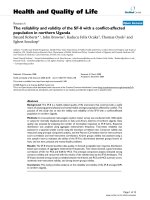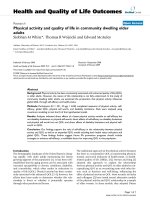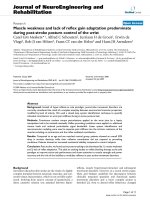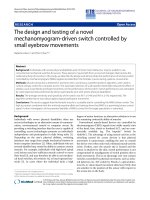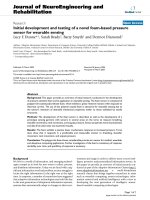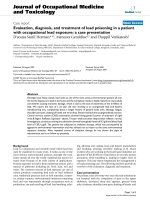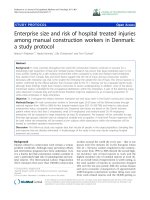Báo cáo hóa học: "Multiscale modeling and simulation of nanotube-based torsional oscillators" docx
Bạn đang xem bản rút gọn của tài liệu. Xem và tải ngay bản đầy đủ của tài liệu tại đây (271.13 KB, 6 trang )
NANO EXPRESS
Multiscale modeling and simulation of nanotube-based torsional
oscillators
Shaoping Xiao Æ Wenyi Hou
Published online: 28 November 2006
Ó to the authors 2006
Abstract In this paper, we propose the first numerical
study of nanotube-based torsional oscillators via devel-
oping a new multiscale model. The edge-to-edge
technique was employed in this multiscale method to
couple the molecular model, i.e., nanotubes, and the
continuum model, i.e., the metal paddle. Without
losing accuracy, the metal paddle was treated as the
rigid body in the continuum model. Torsional oscilla-
tors containing (10,0) nanotubes were mainly studied.
We considered various initial angles of twist to depict
linear/nonlinear characteristics of torsional oscillators.
Furthermore, effects of vacancy defects and tempera-
ture on mechanisms of nanotube-based torsional
oscillators were discussed.
Keywords Nanotube Á Torsional oscillator Á
Multiscale Á Vacancy defects Á Temperature
Introduction
Since the discovery of carbon nanotubes (CNTs) [1]in
1991, these special cylindrical nanostructures have
been intensively studied and discussed. Their extraor-
dinary mechanical and electrical properties [2] ensure
that CNTs will play an essential role in the design of
nanoscale devices, such as nanotweezers [3], nanogears
[4], nanotube motors [5], and axial nano-oscillators [6].
Recently, a nanoelectromechanical device [7–9] based
on an individual CNT serving as a torsional spring and
mechanical support has been successfully fabricated.
Williams and co-workers [7, 8] reported fabrication of
nanoscale mechanical devices, which consist of a
suspended lever, i.e., the ‘‘paddle,’’ connected by
CNTs as torsion beams to stationary leads. Papadakis
et al. [9] used similar techniques to synthesize so-called
torsional oscillators. The metal paddles in their exper-
iments were on CNTs so that the tubes were strained
primarily in torsion. In addition, they predicted that
one of their oscillators could have the resonance
frequency of 0.1 MHz. Applications for this type of
oscillator include being used as sensors and clocks for
high-frequency electronics.
Although experimental observations have indicated
the potential applications of nanotube-based torsional
oscillators, the mechanisms have not been studied
thoroughly. Numerical methods, especially molecular
dynamics (MD) simulation, have become a powerful
tool for revealing complex physical phenomena [6].
Unfortunately, no numerical analysis of nanotube-
based torsional oscillators is reported so far due to the
limitation of MD on length scales. A torsional oscil-
lator may contain up to billions or trillions of atoms
because of the large dimensions of the metal paddle.
Therefore, intensive computation results in the infea-
sibility of MD models of torsional oscillators.
Recently developed multiscale modeling techniques,
such as the bridging domain coupling method [10],
have shown promise in treating phenomena at nano
and larger scales. Based on the edge-to-edge coupling
method [11], we develop a multiscale method to study
the mechanical behavior of nanotube-based torsional
oscillators. In the proposed multiscale model, the
nanotube is modeled with molecular dynamics while
S. Xiao (&) Á W. Hou
Department of Mechanical and Industrial Engineering,
Center for Computer-Aided Design, The University of
Iowa, 3131, Seamans Center, Iowa City, IA 52242, USA
e-mail:
Nanoscale Res Lett (2007) 2:54–59
DOI 10.1007/s11671-006-9030-8
123
the metal paddle is modeled as continua. To simplify
the simulation, the metal paddle is further modeled as
a rigid body. We will investigate mechanisms of
torsional oscillators at various initial angles of twist.
Effects of defects and temperature on mechanisms of
nanotube-based torsional oscillators will also be con-
sidered.
Multiscale modeling
In a nanotube-based torsional oscillator, a part of the
nanotube is embedded in the metal paddle. We believe
this portion of the nanotube has an insignificant effect
on the momentum of inertia of the metal paddle.
Therefore, the nanotube in this oscillator can be
viewed as two individual tubes connecting with the
metal paddle, as shown in Fig. 1, which illustrates the
multiscale model of a carbon nanotube-based torsional
oscillator.
In such a multiscale model, the total domain, W
0
,is
divided into three sub-domains: two molecular
domains (carbon nanotubes), W
M
, and one continuum
domain (the metal paddle), W
C
. This differs from
previous research [10] in that there was an overlapping
subdomain between the continuum and molecular
domains. Indeed, the molecular and continuum
domains are attached with each other via the interfaces
G
int
in this paper. In other words, there are some
carbon atoms on the interface G
int
. In Fig. 1, l is the
length of the carbon nanotube at each side, and d
represents the diameter of the tube. The metal paddle
has the dimensions of length a, width b, and thickness
c. In this paper, we assume that nanotubes attached
with the metal paddle on each side have the same
length.
In a torsional oscillator studied here, the axes of the
nanotubes coincide with each other and are assumed to
pass the centroid of the metal paddle. The axes of the
nanotubes also coincide with the axis that the metal
paddle rotates about, as shown in Fig. 1. Therefore, the
metal paddle mainly has the motion of torsion. We
believe that the metal paddle has no large deformation
during its rotation. Therefore, the metal paddle can be
simplified as a rigid body. The equations of motion are
J
€
h ¼ T; ð1Þ
where J is the angular moment of inertia of the metal
paddle to its centroid, h is the rotation angle of the
metal paddle, and T is the torque applied on the metal
paddle. The torque results from forces of the atoms
located on the interface G
int
due to the torsion of
nanotubes. It has been observed [9] that vertical
deflections of nanotubes could be negligible
compared to torsional deflections. Therefore, the
torque T can be computed by:
Te
z
¼
X
I
r
I
 F
I
; ð2Þ
where F
I
is the atomic force on atom I that is located at
the interface between the nanotube and the metal
paddle, and r
I
is the position vector of atom I with
respect to the tube axis. Both F
I
and r
I
are projected on
the x–y plane, while the tube axis is denoted by e
z
.
In the molecular model, molecular dynamics is
utilized. We employ the modified Morse potential
function, proposed by Belytschko and Xiao [12], to
describe the interaction between bonded carbon
atoms. Since the modified Morse potential consists of
the bond stretching energy and the bond angle-bending
energy, simply gluing carbon atoms on the molecular/
continuum interface will not account for the bond
angle-bending energy between the nanotubes in the
molecular model and the one in the continuum model,
although the tube in the continuum model is ignored
due to the assumption of no deformation. Here, we
employ the molecular/continuum coupling similar to
what proposed in the edge-to-edge coupling method
[11], in which the bond angle-bending potential at the
interface can be considered by introducing virtual
atoms and bonds.
Figure 2 illustrates the molecular/continuum cou-
pling technique utilized in this paper. Carbon atoms e,
f, and g are in the molecular domain, while atom g is
located at the interface. Corresponding to atom g,a
‘‘virtual atom’’ h is inside the continuum model. In
addition, bond gh is the so-called ‘‘virtual bond.’’ It
should be noted that only zigzag nanotubes are
considered in this paper. A similar strategy can be
conducted for other nanotubes such as armchair tubes.
Since the metal paddle is viewed as a rigid body, virtual
Fig. 1 Multiscale model of a CNT-based torsional oscillator
123
Nanoscale Res Lett (2007) 2:54–59 55
bonds have no change in their length, so there is no
change in the bond-stretching energy of virtual bonds.
However, the angles between the virtual bonds and
their neighboring bonds in the molecular model, e.g.,
the ones between bonds gh and ge/gf shown in Fig. 2,
may change during the rotation of the metal paddle
and the torsion of the nanotube so that the bond angle-
bending potential exists at the molecular/continuum
interface. Such an angle-bending potential must be
considered in molecular dynamics simulations because
it affects the atomic forces of carbon atoms that are on
or close to the molecular/continuum interfaces. In the
example given in Fig. 2, those atoms include atoms e, f,
and g. Consequently, the equations of motion in the
molecular model are
m
I
x
I
¼ f
ext
I
À
@ðE þ E
virtual
Þ
@x
I
; ð3Þ
where x
I
is the location of atom I and f
I
ext
is the external
force applied on the atoms. The external force can be
due to the gravity of the metal paddle. E is the
potential energy of the tubes in the molecular model;
E
virtual
is the potential due to angle change between the
virtual bonds and other realistic bonds at the molec-
ular/continuum interfaces.
One of the keys in this multiscale modeling is to
identify the location of virtual atoms. We employ finite
element approximation by treating the entire metal
paddle as an eight-node block element. The kinetic
variables of a virtual atom are evaluated from eight
nodes located at vertices of the metal paddle.
At the beginning of a multiscale simulation, the
metal paddle is given an initial angle of twist. There-
fore, the displacements of atoms at the continuum/
molecular interfaces and virtual atoms can be deter-
mined through finite element approximation in the
continuum model as boundary conditions in the
molecular model. Molecular dynamics simulation in
the molecular model is conducted through solving the
equations of motion in Eq. 3. The Verlet velocity
algorithm is employed. At each time step, we use Eq. 2
to calculate the torque acting on the metal paddle. This
torque is due to the atomic forces of atoms on the
continuum/molecular interfaces. Then, the rotation of
the metal paddle can be determined by solving Eq. 1.
The above procedure is iterative until the target time is
reached.
Results and discussions
In this paper, we mainly consider torsional oscillators
that contain (10,0) tubes. We first study the mechanical
behaviors of torsional oscillators that are isolated
systems at zero temperature initially. Nanotubes with
the length of 4.12 nm connect and support the metal
paddle. The material of the metal paddle is gold, which
has a density of 19,300 kg/m
3
. The dimensions of the
metal paddle are: length of 4.18 nm, width of 10.0 nm,
and thickness of 3.2 nm. Consequently, the angular
moment of inertia of the metal paddle is 0.0237e–
36 kg m
2
. The metal paddle is initially given a twist
angle of 10° . With the multiscale simulation, we
obtained the evolution of angle change for the metal
paddle, as shown in Fig. 3. The resonant oscillation is
stable, and the calculated frequency is 3.34 GHz.
Here, we consider (10,0) tubes with various lengths,
including 8.38, 12.64, 16.90, and 21.16 nm. The calcu-
lated resonance frequencies are 2.35, 1.92, 1.67 and
Fig. 3 Evolution of angle change of the metal paddle in a
torsional oscillator containing (10,0) tubes
Fig. 2 The schematic diagram of virtual atoms/bonds at the
interface
123
56 Nanoscale Res Lett (2007) 2:54–59
1.50 GHz, respectively. It can be seen that resonance
frequencies are inversely proportional to the square
root of the nanotube length. Furthermore, if the same
(10,0) nanotubes are used, but the angular moment of
inertia of the metal paddle is increased by 2, 4, and 8
times, the simulation outcomes indicate that resonance
frequencies are reduced by
ffiffiffi
2
p
, 2 and 2
ffiffiffi
2
p
times,
respectively. Based on the above data, the following
relation of frequencies between any two nanotube-
based torsional oscillators can be concluded:
f
1
f
2
¼
ffiffiffiffiffiffiffiffi
J
2
l
2
J
1
l
1
s
ð4Þ
where f
1
and f
2
are the frequencies, J
1
and J
2
the
angular moments of inertia of the metal paddles, and l
1
and l
2
the length of nanotubes in torsional oscillators 1
and 2, respectively. It should be noted that nanotubes
in those two torsional oscillators have the same
diameter.
It is known that the resonance frequency, f,ofa
linear torsional oscillation system can be theoretically
predicted via the following equation:
f ¼
1
2p
ffiffiffi
k
J
r
; ð5Þ
where k is the torsional stiffness of the embedded
linear torsional spring and J is the angular moment of
inertia of the paddle. Indeed, Eq. 4 can be derived
from Eq. 5 since nanotubes’ torsional stiffness is
inversely proportional to the length if nanotubes are
taken as linear torsional springs. At this point, the
proposed multiscale modeling is verified with theoret-
ical prediction.
In previous research [W.Y. Hou and S.P. Xiao,
submitted ], a carbon nanotube was observed to have a
constant torsional stiffness within small angles of twist.
Therefore, nanotubes can be viewed as linear torsional
elements, and frequencies of torsional oscillators can
be predicted via Eq. 4 or 5. However, carbon nanotu-
bes exhibit nonlinear characteristics when being
employed as torsional springs under large angles of
twist. If the angle of twist becomes larger, the nano-
tube’s torsional stiffness becomes smaller until the
torsional buckling occurs. In these cases, frequencies of
torsional oscillators cannot be predicted by Eq. 4 or 5
anymore. The developed multiscale method is an
alternative. For the torsional oscillator we studied
above, the calculated resonance frequency is 3.34 GHz
(see Fig. 3) when the initial angle of twist is 10°.If
initial angles of twist become 30° and 60°, the
resonance frequencies are dropped to 3.06 GHz and
2.49 GHz, respectively. It should be noted that we do
not consider the occurrence of buckling in this paper.
Research has shown that vacancy defects can dra-
matically reduce the stiffness, strength, and torsional
stiffness of nanotubes [W.Y. Hou and S.P. Xiao,
submitted, 13]. Therefore, we believe that vacancy
defects have significant effects on the resonance
frequencies of nanotube-based torsional oscillators.
Vacancy defects can be caused by ion irradiation,
absorption of electrons, or nanotube fabrication pro-
cesses. Such defects are modeled by taking out atoms,
followed by bond reconstruction [13]. In this paper, we
consider two uncertainties associated with vacancy
defects on nanotubes. One is the number of missing
atoms, and the other is the location of a vacancy defect.
Due to the unique structures of single-walled carbon
nanotubes, they can be mapped onto two-dimensional
(2D) graphene planes with a thickness of 0.34 nm.
Consequently, a 3D model can be simplified as a 2D
surface problem when considering vacancy defects on
nanotubes. On the other hand, since vacancy defects
occur on carbon nanotubes in a completely random
manner, we employ a homogeneous Poisson point
process to determine the occurrence probability of a
specified number of Poisson points, i.e., missing atoms
in this paper, via
PðNðAÞ¼kÞ¼
e
ÀkA
ðkAÞ
k
k!
; k ¼ 1; 2; 3 ð6Þ
where A is the plane area, N(A) is the number of
Poisson points (missing atoms) on this area A, and k is
the Poisson point density (missing atom density) per
area.
For a given number of Poisson points, they are
deposed on a two-dimensional graphene sheet, to
which the considered nanotube can be mapped, at
random positions. We mark the carbon atoms, which
are the nearest ones to the Poisson points, as the
missing atoms. After taking out the missing atoms, we
perform bond reconstruction to generate one-atom,
two-atom, and/or cluster-atom vacancy defects. Even
for the same number of missing atoms, the numbers
and locations of vacancy defects can vary from case to
case. For example, a vacancy-defected (10,0) nanotube
shown in Fig. 4 contains five one-atom vacancies, two
two-atom vacancies, and one cluster-atom vacancy.
Fig. 4 A (10,0) nanotube with randomly located vacancy defects
123
Nanoscale Res Lett (2007) 2:54–59 57
In this study, we choose (10,0) tubes with the length
of 4.12 nm as torsional springs for nanotube-based
torsional oscillators. The surface area of the carbon
nanotube is 20.24 nm
2
. The metal paddle has an
angular moment of inertia of 0.0237e–36 kg m
2
. The
following missing atom densities are considered: 0.1, 1,
2 and 3 nm
–2
. For each given missing atom density, 100
simulations are conducted. The number of simulations
for a specific number of missing atoms is based on its
probability via Eq. 6. Figure 5 shows the relationship
between the resonance frequency and the missing atom
density on the carbon nanotube surface. Due to
uncertainties of vacancy defects, the resonance fre-
quencies follow the Gaussian distribution. We can see
that on average a larger missing atom density results in
a lower resonance frequency since the nanotube with
more missing atoms generally has less torsional stiff-
ness. However, due to the uncertainties of vacancy
defects, it is possible that a torsional oscillator embed-
ding a nanotube with more missing atoms has higher
resonance frequency.
Previous research showed that temperature effects
were significant on mechanisms of some nanoscale
devices [6]. We first investigate temperature effects on
the frequencies of nanotube-based torsional oscillators.
(10,0) nanotubes with the length of 8.24 nm are
selected as torsional springs in resonant oscillators.
The metal paddle has a moment of inertia of
0.1261 · 10
–36
kg m
2
with respect to the rotation axis,
i.e., tube axis. The oscillator has a frequency of
1.45 GHz when it is an isolated system. Here, we
conducted multiscale simulations at various tempera-
tures. In the molecular model, the Hoover thermostat
is employed [14] to maintain nanotubes at a constant
temperature. The frequencies are calculated based on
the oscillation of the metal paddle during the first
several cycles. The calculated frequencies are 1.44,
1.42, 1.40, and 1.35 GHz at 100, 300, 600 and 800 K,
respectively. It is evident that temperature has a slight
effect on the resonance frequencies of nanotube-based
torsional oscillators. However, we observed another
phenomenon: energy dissipation of the torsional oscil-
lators at a finite temperature.
Energy dissipation is always observed when nano-
scale devices are at finite temperatures [6] due to the
heat exchange between devices and their surroundings.
Here, we study the energy dissipation of torsional
oscillators with various frequencies, including 5.53,
10.99, 15.39, 30.30 and 38.46 GHz, at the room
temperature of 300 K. It should be noted that the
same (10,0) nanotubes with the length of 4.12 nm are
employed in those oscillators. Various frequencies are
due to different dimensions of the metal paddles. The
evolutions of the maximum angular kinetic energies of
those torsional oscillators are shown in Fig. 6.Itis
evident that high frequency results in large energy
dissipation. For the torsional oscillator having the
frequency of 38.46 GHz, the system energy dissipates
85% during 2 ns. It is known that temperature is one of
the macroscopic parameters and is related to the
kinetic energy of atoms. We believe that the high-
speed rotation of the metal paddle drives large
vibration of atoms during the torsion of the nanotube.
Therefore, the temperature of the nanotube is higher
in the torsional oscillator with a higher resonance
frequency. Consequently, the loss of energy is faster
due to the high temperature gradient between the
torsional oscillator and its surrounding.
To validate the proposed multiscale modeling, we
employ the experimental outcomes of Papadakis et al.
[9] as the reference. They tested nine devices and
Fig. 5 Vacancy defect effects on the resonance frequency (solid
line represents mean values of resonance frequencies that follow
the Gaussian distribution; vertical lines represent + /– one
standard deviation)
Fig. 6 Energy dissipation of nanotube-based torsional oscillators
with various resonance frequencies at 300 K
123
58 Nanoscale Res Lett (2007) 2:54–59
obtained resonance frequencies between 1.68 and
4.12 MHz. The comparison is illustrated in Table 1.It
can be seen that multiscale simulations provide close
values (F
1
) to experimental observations (F
0
) for
Devices 1 and 2. However, all the calculated frequen-
cies are lower than the experimental outcomes. This is
because we only model the outermost tube of the
multi-walled carbon nanotubes (MWNT) that were
utilized in the experiments. With the consideration of
fully mechanical coupling [9] between interlayer tubes,
we predict the resonance frequencies (F
2
), which are
close to the experimental results for Devices 5, 6, 7,
and 8. Furthermore, all the measured frequencies are
in the ranges of numerical solutions. Variations may be
due to vacancy defects on the nanotubes, as in the
preceding discussion.
Although nanotube-based torsional oscillators were
fabricated and observed through experimental tech-
niques, numerical studies have not been reported yet.
We propose a multiscale method in which the metal
paddle was treated as the rigid body while nanotubes
were modeled by molecular dynamics. The multiscale
method has advantages for investigating the nonlinear
characteristics of nanotube-based torsional oscillators,
including the effects of vacancy defects and tempera-
ture. Such a multiscale method can be extended to
model and study other nanodevices.
Acknowledgments The authors acknowledge support from the
Army Research Office (Contract: # W911NF-06-C-0140) and the
National Science Foundation (Grant # 0630153).
References
1. S. Iijima, Nature 354, 56 (1991)
2. V.N. Popov, Mater. Sci. Eng. R 43, 61 (2004)
3. P. Kim, C.M. Lieber, Science 286, 2148 (1999)
4. D. Srivastava, Nanotechnology 8, 186 (1997)
5. J.W. Kang, H.J. Hwang, Nanotechnology 15, 1633 (2004)
6. S.P. Xiao, D. Andersen, R. Han, W.Y. Hou, Int. J. Theo.
Comput. Nano. 3, 143 (2006)
7. P.A. Williams, S.J. Papadakis, A.M. Patel, M.R. Falvo, S.
Washburn, R. Superfine, Phys. Rev. Lett. 89, 255502 (2002)
8. P.A. Williams, S.J. Papadakis, A.M. Patel, M.R. Falvo, S.
Washburn, R. Superfine, Phys. Rev. Lett. 82, 805 (2003)
9. S.J. Papadakis, A.R. Hall, P.A. Williams, L. Vicci, M.R.
Falvo, R. Superfine, S. Washburn, Phys. Rev. Lett. 93,
146101 (2004)
10. S.P. Xiao, T. Belytschko, Comp. Meth. Appl. Mech. Engrg.
193, 1645 (2004)
11. T. Belytschko, S.P. Xiao, Int. J. Mult. Comput. Engrg. 1, 115
(2003)
12. T. Belytschko, S.P. Xiao, G. Schatz, R. Ruoff, Phys. Rev. B
65, 235430 (2002)
13 S.L. Mielke, D. Troya, S.L. Zhang, J.L. Li, S.P. Xiao, R. Car,
R.S. Ruoff, G.C. Schatz, T. Belytschko, Chem Phys Lett 390,
413 (2004)
14 W.G. Hoover, Phys Rev A 31, 1695 (1985)
Table 1 Comparison of numerical results with experimental
outcomes
Devices F
0
(MHz) F
1
(MHz) F
2
(MHz)
1 1.68 1.33 2.91
2 2.37 1.84 5.90
3 2.50 1.53 5.00
4 3.27 2.30 8.37
5 2.92 1.28 3.20
6 3.79 1.38 3.83
7 4.12 1.60 4.24
8 2.98 1.06 3.11
9 2.04 0.97 2.74
F
0
is the resonance frequency measured by Papadakis et al. [9],
F
1
is the frequency calculated via the proposed multiscale
method, and F
2
is the numerical result considering mechanical
coupling
123
Nanoscale Res Lett (2007) 2:54–59 59



